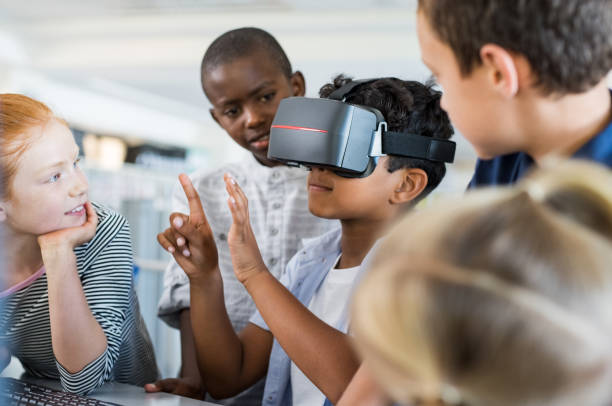Technology has become an inseparable part of our lives, and the education sector is no exception. With the rapid technological advancements, technology in schools is now used to enhance the learning experience.
While some people believe that technology has revolutionized education, others are skeptical about its impact.
In this article, we will explore the pros and cons of integrating technology in schools to help teachers, school owners, and parents make an informed decision.
Table of Contents
- What is Technology?
- Importance of Technology in Schools
- Teaches Students how to Behave Responsibly on the Internet
- Advantages of Using Technology in Schools
- Technology in Schools Pros and Cons
- Challenges and Concerns of Implementing Technology in Schools
- Case Studies and Examples
- Challenges Faced by Schools
- FAQS About Technology in Schools
- Conclusion
- References
- Our Recommended Posts
What is Technology?
Technology is the use of conceptual knowledge to accomplish practical objectives, particularly in a repeatable manner. The term “technology” can also refer to the end products of these endeavors, encompassing both material instruments like machinery or utensils and immaterial ones like software.
Importance of Technology in Schools
Our world has been overtaken by technology, which has fundamentally altered the way we work, live, and study.
Technology has changed the teaching and learning process in the education industry, changing the rules. Below is a few important of technology in education:
Boosts Innovation and Creativity
High school Students now have a plethora of options to be creative and innovative because of technology. With an abundance of knowledge and tools at their disposal, students can experiment, investigate, and realize their ideas.
Students find this kind of practical instruction to be far more interesting and pleasurable, and it promotes critical thinking abilities. Primary school students can utilize graphic design tools, for instance, to make films, animations, or posters to showcase their ideas.
They can develop and produce prototypes of their inventions using 3D printing. To make their concepts more engaging and realistic, they can even make use of virtual and augmented reality.
Encourages Individualized Education
Tailored learning is one of the main advantages of technology in education. Then students can gain knowledge that is specific to their needs, interests, and learning styles by using instructional software and online resources.
They can also get information that is pertinent to their studies, work at their own pace, and repeat sessions as needed. Students who receive this kind of specialized instruction are more likely to stay motivated and produce better work.
Also Read: What is The Average Class Size of Secondary Schools in the UK?
Enhances Interaction and Cooperation
The way educators, administrators, and students interact and communicate has been completely transformed by technology. Students can collaborate on projects, share ideas, and remain in touch no matter where they are thanks to social media and internet platforms.
Students can even collaborate on projects with peers from different universities or nations, removing boundaries between locations and fostering a feeling of community inside the classroom.
Also, educators can use technology to design interactive lectures, administer online assessments and quizzes, and provide students immediate feedback to help them remain on course and perform better.
Teaches Students how to Behave Responsibly on the Internet
It should come as no surprise that pupils are already accustomed to using digital devices given the abundance of social media platforms available.
However, teachers may teach these pupils how to be responsible and have a beneficial impact on the digital world by integrating technology into the classroom.
Students can practice speaking, searching, and connecting with others just like they would in the real digital world by turning the classroom into a little version of the online world.
Makes Education More Enjoyable
Today’s students use technology a lot in their daily lives outside of the classroom. However, using technology in the classroom can support the teaching of the subject matter in addition to making it more engaging for students.
Game-based learning (GBL) is a cutting-edge approach to education that uses leaderboards and interactive games to deliver lessons, giving students a far more interesting learning experience.
Students can add a creative element to their study by using technology to produce multimedia projects and share them with their classmates.
Virtual reality (VR) and augmented reality (AR) have made it possible for students to engage in hands-on learning experiences that bring subjects to life through virtual field trips and simulations.
Read Also: What Time Do Schools Start and Finish in the UK?
Equips Students for the Future
One of the most important tools for educating children for the future is technology. Technology is having a big impact on the fast-changing workforce. The abilities necessary for success in the digital age must be taught to students.
Students can learn a variety of crucial abilities, like problem-solving, critical thinking, and teamwork, with the help of technology. And, it exposes them to a range of digital resources and platforms, assisting in their development as competent and self-assured users.
Advantages of Using Technology in Schools
The several advantages of technology in classrooms include:
Enhanced Learning Experience
Technology has transformed the way students learn by making education interactive and engaging. With the use of multimedia tools such as videos, animations, and interactive simulations, students can learn complex concepts in a fun and easy way.
Furthermore, technology has enabled teachers to create virtual classrooms where students can access learning materials anytime, anywhere.
Improved Engagement and Participation
Technology has made learning more engaging and interactive. With the use of digital tools such as interactive whiteboards, students can participate in class activities and share their ideas with their peers.
Additionally, technology has enabled teachers to create personalized learning experiences that cater to the needs of each student, which can significantly improve their engagement and participation.
Personalized Learning
Technology has made it possible for students to learn at their own pace. With the use of adaptive learning technologies, students can receive personalized learning experiences that suit their learning needs.
This means that students can learn at a pace that is comfortable for them, which can significantly improve their learning outcomes.
See Also: 75 Cutest Sorority Big Little Basket Ideas That You’ll Love
Technology in Schools Pros and Cons
The way we communicate, live and even learn has been altered by technology. While there are many benefits associated with the use of technology in education, there are certain drawbacks as well.
You will be heavily impacted by technology as a high school or college student, both in your daily life and your academic pursuits.
To get the most out of technology in the classroom and to carefully tread the line to maximize its benefits, it’s vitally necessary to comprehend both sides of the issue. The benefits and drawbacks of utilizing technology in the classroom.
Pros of Education Using Technology
Activating Educational Process
Technology increases the interactivity and interest of learning. For example, applications, games, and simulations can be used by students to learn a subject.
Because it accommodates a variety of learning preferences and helps pupils recall material better, this approach of teaching is more successful.
Information Accessibility
The days when students had to visit the library and leave through stacks of volumes to find knowledge on a certain subject are long gone.
With the use of technology, kids can easily access a large amount of knowledge. No matter where they are, they may readily read, investigate, and learn about any subject.
Disadvantages of Technology Use in Schools
Complete Distraction
Technologies like social media, internet gaming, and surfing can become distractions when used in the classroom. Poor academic performance might result from students’ easy loss of focus on the current assignment.
Cost
For schools with tight budgets, integrating technology into the classroom can be expensive. As a result, kids may have less access to technology and less opportunity for equal learning.
See: How Long Does A High School Basketball Game Usually Last In 2024?
Challenges and Concerns of Implementing Technology in Schools
Access and Equity Issues
While technology has the potential to enhance the learning experience, not all students have equal access to it.
Students from low-income families or rural areas may not have access to the necessary technology to participate in online classes or access digital learning materials.
This can worsen the existing achievement gap, where students from disadvantaged backgrounds are already at a disadvantage.
Overreliance on Technology
Another concern of integrating technology in schools is the overreliance on it.
While technology can enhance the learning experience, it should not replace traditional teaching methods.
Teachers should strike a balance between using technology and traditional teaching methods to ensure that students receive a well-rounded education.
Privacy and Security Concerns
With the increasing use of technology in schools, privacy and security concerns have become more prevalent.
Schools need to ensure that they have robust security measures in place to protect student data and prevent cyber attacks.
Additionally, teachers need to educate students on online safety and responsible use of technology.
Also See: Basketball Stars Unblocked: Best Games To Play Online In 2024
Case Studies and Examples
Successful Implementation Stories
There are many success stories of schools that have successfully integrated technology into their curriculum.
For example, the Rocketship Education network of charter schools has implemented a personalized learning model that uses adaptive learning technologies to enhance the learning experience.
As a result, Rocketship Education schools have achieved remarkable academic results, with 90% of students meeting or exceeding their grade-level standards.
Challenges Faced by Schools
On the other hand, there are also many challenges that schools face when implementing technology.
For example, the Los Angeles Unified School District implemented a $1.3 billion initiative to provide every student with an iPad.
However, the initiative faced several challenges, including technical difficulties and concerns over security and privacy.
The Future of Technology in Education
Emerging Technologies
The future of technology in education looks promising, with many emerging technologies that have the potential to revolutionize the learning experience.
For example, artificial intelligence (AI) has the potential to personalize learning even further by analyzing student data and providing personalized recommendations.
Prospects and Potential Benefits
There are many potential benefits of integrating technology in schools, including improved learning outcomes, enhanced engagement and participation, and personalized learning experiences.
Also, technology can prepare students for the digital world and the future job market.
Read More: Top 10 Grammar Schools in London in 2024
FAQS About Technology in Schools
Integrating technology in schools offers several benefits, including enhanced learning experiences through interactive tools and online resources.
It improves student engagement and participation through gamification and collaborative learning platforms. Personalized learning, facilitated by adaptive software, tailors education to individual student needs, fostering a more effective and efficient learning environment.
Access and equity issues, such as the digital divide, can create disparities in students’ access to technology.
Overreliance on technology can impact social skills and balance between screen time and other activities. Privacy and security concerns, especially regarding student data protection and cybersecurity threats, require careful consideration and management.
Yes, there are numerous successful examples of technology implementation in schools worldwide. Many schools have effectively used technology to enhance learning, improve student engagement, and prepare students for the future job market.
Emerging technologies like artificial intelligence, virtual reality, and augmented reality are revolutionizing classroom experiences.
Conclusion
In conclusion, the use of technology in schools has its pros and cons. While technology can enhance the learning experience, it can also exacerbate existing inequalities and create new challenges.
Therefore, schools need to strike a balance between using technology and traditional teaching methods to ensure that students receive a well-rounded education.
Additionally, schools need to ensure that they have robust security measures in place to protect student data and prevent cyber attacks.
References
- brookings.edu _______ Is technology good or bad for learning?
- gcu.edu _________ How Using Technology in Teaching Affects Classrooms
- lumenlearning.com ________ 10 Benefits & Uses for Technology in the Classroom
- elearningindustry.com ______ Educational Technology: How Important Is It In Today’s Education Industry?



